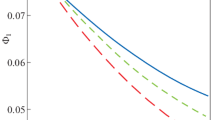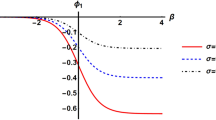Abstract
Two dimensional ion acoustic shocks in electron-positron-ion (e-p-i) plasma with warm ions, and nonthermal electrons and positrons following the q-nonextensive velocity distribution are studied in the presence of weak transverse perturbations. The kinematic viscosity of warm ions is included for the dissipation in the plasma system. Kadomtsev–Petviashvili–Burgers (KPB) equation is derived by using reductive perturbation method in small amplitude limit and its analytical solution is also presented. The effects of variations of positrons concentration, q-indices of electrons and positrons, ion temperature and kinematic viscosity of ions, on the propagation characteristic of two dimensional shock profile are also discussed.










Similar content being viewed by others
References
Alinejad, H., Sobhanian, S., Mahmoodi, J.: Phys. Plasmas 13, 012304 (2006)
Berezhiani, V.I., Mahajan, S.M.: Phys. Rev. Lett. 73, 1110 (1994)
Beskin, V.S.: Phys. Usp. 53, 1199 (2006)
El-Awady, E.I., Moslem, W.M.: Phys. Plasmas 18, 082306 (2011)
El-Tantawy, S.A., Tribeche, M., Moslem, W.M.: Phys. Plasmas 19, 032104 (2012)
Ghosh, U.N., Chatterjee, P.: J. Plasma Phys. 79, 789 (2013)
Ghosh, U.N., Chatterjee, P., Kundu, S.K.: Astrophys. Space Sci. 339, 255 (2012a)
Ghosh, U.N., Chatterjee, P., Tribeche, M.: Phys. Plasmas 19, 112302 (2012b)
Ghosh, D.K., Chatterjee, P., Ghosh, U.N.: Phys. Plasmas 19, 033703 (2012c)
Ghosh, D.K., Mandal, G., Chatterjee, P., Ghosh, U.N.: IEEE Trans. Plasma Sci. 41, 1600 (2013)
Hussain, S., Akhtar, N.: Phys. Plasmas 20, 012305 (2013)
Hussain, S., Akhtar, N., Mahmood, S.: Astrophys. Space Sci. 343, 329 (2013a)
Hussain, S., Mahmood, S., Ur-Rehman, H.: Phys. Plasmas 20, 062102 (2013b)
Infeld, E., Rowlands, G.: Nonlinear Waves, Solitons and Chaos, p. 346. Cambridge University Press, Cambridge (2000)
Jeffrey, A., Kakutani, T.: SIAM Rev. 14, 582 (1972)
Jehan, N., Mirza, A.M., Salahuddin, S.M.: Phys. Plasmas 18, 052307 (2011)
Kadomtsev, B.B., Petviashvili, V.I.: Sov. Phys. Dokl. 15, 539 (1970)
Kourakis, I., Verheest, F., Cramer, N.: Phys. Plasmas 14, 022306 (2007)
Mamun, A.A., Shukla, P.K.: Phys. Plasmas 9, 1468 (2002)
Masood, W., Rizvi, H.: Phys. Plasmas 17, 052314 (2010)
Nejoh, Y.N.: Phys. Plasmas 3, 4 (1996)
Popel, S.I., Vladimirov, S.V., Shukla, P.K.: Phys. Plasmas 2, 716 (1995)
Renyi, A.: Acta Math. Hung. 6, 285 (1955)
Roy, K.A., Misra, P., Chatterjee, P.: Phys. Plasmas 15, 032310 (2008)
Sahu, B.: Phys. Plasmas 18, 082302 (2011)
Sahu, B., Roychoudhury, R.: Phys. Plasmas 14, 072310 (2007)
Silva, R., Plastino, A.R., Lima, J.A.S.: Phys. Lett. A 249, 401 (1998)
Su, C.H., Gardner, C.S.: J. Math. Phys. 10, 536 (1969)
Taniuti, T., Wei, C.C.: J. Phys. Soc. Jpn. 24, 941 (1968)
Tsallis, C.: J. Stat. Phys. 52, 479 (1988)
Tsallis, C.: Chaos Solitons Fractals 6, 539 (1995)
Washimi, H., Taniuti, T.: Phys. Rev. Lett. 17, 996 (1966)
Xue, J.-K.: Phys. Plasmas 10, 3430 (2003a)
Xue, J.-K.: Phys. Lett. A 314, 479 (2003b)
Xue, J.-K.: Phys. Plasmas 10, 4893 (2003c)
Acknowledgements
S. Hussain is thankful to HEC (Higher Education commission) Pakistan for their financial assistance to visit university of Alberta through IRSIP( International Research support Initiative Program) via No 1-8/HEC/HRD/2013/2799.
Author information
Authors and Affiliations
Corresponding author
Appendix: Parameters stretching and expansion
Appendix: Parameters stretching and expansion
The linear dispersion relation for two dimensional ion acoustic shocks in an electron-positron-ion (e-p-i) plasma with warm ions, while electrons and positrons follow q-nonextensive velocity distribution is described in Eq. (7). The basic procedure to find stretching of independent variables has been discussed by Washimi and Taniuti (1966), Taniuti and Wei (1968), Su and Gardner (1969), Jeffrey and Kakutani (1972).
Here, we find the variable stretching for the plasma model given in Eqs. (1)–(6). For simplicity, we ignore the viscosity of the ions and assumes the ions are cold (i.e., T i =0) as well for studying ion acoustic wave only. It is also deemed that the electrons and positrons are of the same temperature (i.e., T e =T p ). Under these assumptions Eq. (7) in normalized form can be written as,
where ω n and k n are the normalized forms of ω and k, where L is defined as \(L =\sqrt{\frac{(q_{e}+1)+p(q_{p}+1)}{2}}\).
The normalized wave number k n is defined as
In the perturbation scheme, it is assumed that the wave number k n is small and k x ≫k y , therefore Eq. (29) will gives
Equation (28) with the help of Eq. (30) will take the form
For sinusoidal oscillations, we take perturbations in the form,
The dispersion relation described in Eq. (31) of the linearized system with Eq. (31) leads to the phase
Now the wave is proportional to \(k_{x}=\epsilon ^{1/2}k_{x}'\) and \(k_{y}=\epsilon ^{r}k_{y}'\), therefore Eq. (32) can be written as
Equation (34) suggests (Infeld and Rowlands 2000), ϵ 2r−2=1 which gives r=1.
Thus the stretched variables can be written as
As it is already mention that the variable quantities in the x-direction are stronger than in the y-direction. Equation (35) suggests that the y-component of velocity will vary as \(\epsilon ^{r+\frac{1}{2}}\). The dependent variables are expected of the form
For r=1 Eq. (36) will become
The dependence of plasma parameters such as p (positron density) and q α (nonextensivity for electrons and positrons) appears in the expression of phase velocity λ of the wave.
Rights and permissions
About this article
Cite this article
Hussain, S., Ur-Rehman, H. & Mahmood, S. Two dimensional ion acoustic shocks in electron-positron-ion plasmas with warm ions, and q-nonextensive distributed electrons and positrons. Astrophys Space Sci 351, 573–580 (2014). https://doi.org/10.1007/s10509-014-1868-0
Received:
Accepted:
Published:
Issue Date:
DOI: https://doi.org/10.1007/s10509-014-1868-0




